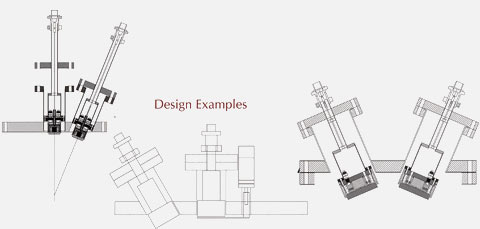| Home | News | About Us | Contact |
 |
Visit Meivac Website |
Sputtering Sources
Product
Since the 1980's, MeiVac's US Components DIvision has acquired multiple exclusive manufacturing and distribution licenses for patented planar magnetron sputter sources from two prominent "Silicon Valley" research laboratories. With over 6,000 of these sources delivered worldwide, the US Components Division has become known as a leading manufacturer of sputter deposition sources, substrate heaters and associated hardware. Introduced in the 1990's, one of the sources, the MAK, rapidly became a standard in the industry. Noted for its simplicity, ease of use and resulting high reliability, the MAK source has been designed to present the smallest profile possible and deliver higher deposition rates than any comparable sputter sources. Because of its popularity, the MAK source has been used in the development of many of today's thin film processes. The MAK source is produced at MeiVac's San Jose, California U.S.A. facility.
ProcessSputtering, which is a Physical Vapor Deposition (PVD) coating technique, is a common method of depositing both metal layers and insulating layers on a substrate. The layers being deposited can be elements such as Cum Au, etc., alloys such as Alcu, NiFe, etc. or insulators such as SiO2, TiN, etc. |
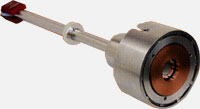 4" MAK Linear Manually Adjustable Source |
Company
The MeiVac team has been serving the vacuum industry for more than 30 years. Founded as Comptech, the company established itself as a multi-faceted vertically integrated vacuum systems, components and services supplier. This capability continued to grow as the company was acquired by Alcatel in the 1980's and then re-acquired and renamed MeiVac in the 1990's. In May 2006, MeiVac acquired the Sputter Source business of US, Inc. and combined it with its Throttle Valve business to form the MeiVac US Components Division. Not only did this acquisition give MeiVac a strong addition to its product portfolio, it also gave the company access to an existing worldwide distribution network.Today, MeiVac has a full array of internal design capabilities, including mechanical, vacuum, electrical, control, and software disciplines. Government certification standards for fabrication techniques (e.g. SST & Aluminium welding) are universally applied to life critical and production critical projects alike. Such design and fabrication capabilities permit close control over critical component quality and delivery.
Principles of Sputtering
Typically, a substrate (the item to be coated) is placed in a vacuum chamber opposite a target (made of the coating material being sputtered). The chamber is evacuated and then backfilled with a process gas (Argon). The gas is ionized with a positive charge, which creates plasma. Resulting ions are strongly attracted to the target, which carries a negative charge. The effect is a physical process similar to the interaction of billiard balls in a confined space. As the relatively large argon ions impact the target, atoms/molecules of target material are physically removed from the target. Due to it's close proximity, a a majority of sputtered atoms/molecules land on the substrate. The intent is for this material to arrive at the substrate with enough energy to form a thin, strongly attached film, one monolayer at a time.Planar Magnetron Sputtering
Cross Section of a Planar Magnetron
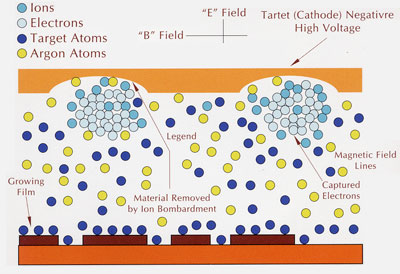
Planar Magnetron Sputtering
In conventional diode sputtering, electrons are created that escape the effective plasma area near the target. Some fly around the chamber creating undesirable undesirable side effects, such as heating the tooling. A magnetron-sputtering source addresses the electron problem by placing the magnets behind, and sometimes, at the sides of the target. These magnets capture the escaping electrons and confine them to the immediate vicinity of the target. This increases the ion current (density of ionized argon atoms hitting the target) by a factor of 10 over conventional diode targets, resulting in faster deposition rates at lower pressures, which help to produce cleaner films.Film Sputtering
Deposition rate, film structure and layer uniformity of deposition materials are highly dependant on:MAK Sputter Sources
Target is retained by the magnet structure with a simple keeper. Target exchange is accomplished in moments without disassembly. MAK sources are designed to overcome limitations commonly found in other sources:![]() Water channel is NOT part of the high voltage path
Water channel is NOT part of the high voltage path
![]() Magnets are NOT in the water channel
Magnets are NOT in the water channel
![]() Target change does NOT require source disassembly
Target change does NOT require source disassembly
![]() Only one vacuum seal and NO water to vacuum seals
Only one vacuum seal and NO water to vacuum seals
![]() Target requires NO clamping or bonding to cathode
Target requires NO clamping or bonding to cathode
![]() Magnetic Materials may be sputtered with the standard magnetic assembly in most applications.
Magnetic Materials may be sputtered with the standard magnetic assembly in most applications.
![]() Operates in DC or RF modes
Operates in DC or RF modes
![]() Process pressures 0.5 - 600 mTorr
Process pressures 0.5 - 600 mTorr
![]() Adjustable anode, improves uniformity, prevents build up and shadowing
Adjustable anode, improves uniformity, prevents build up and shadowing
![]() HV or UHV designs
HV or UHV designs
Magnetron Configuration
MeiVac offers a number of options to assist in achieving desired results. The standard model MAK source is mounted on a 12"(300mm) long support with a position clamp included. Water and power are contained at atmospheric pressure within this support. A 0.75"/19mm Quick Coupler vacuum feedthrough is required to integrate the source in the vacuum system and position it at the correct source to substrate distance.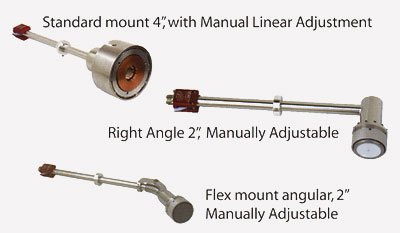
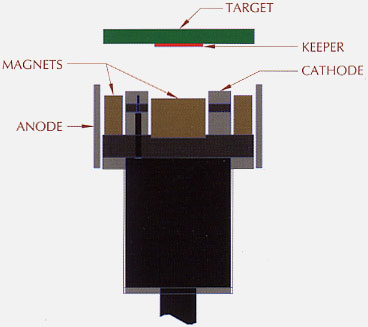
Optional Sources and Features

Operating Specifications
| MAK Model | 1.3" | 2.0" | 3.0" | 4.0" | 6.0" |
| Mounting Flange CF (O.D.) | 4.5 in 114 mm |
4.5 in 114 mm |
6.0 in 152 mm |
8.0 in 203 mm |
10.0 in 254 mm |
| Target Diameter | 1.3 | 2.0 | 3.0 | 4.0 | 6.0 |
| Magnets | Nd / Fe B |
||||
| DC Max Pwr | 350W | 1000W | 2000W | 3000W | 6000W |
| RF Max Pwr | 200W | 400W | 750W | 1200W | 2000W |
| Cathode (V) | 200 - 1000 |
||||
| Discharge Current (Max amps) | 1.00 | 3.00 | 5.00 | 7.00 | 10.00 |
| Min Operating Pressure (mtorr) | 0.5 - 600 |
||||
| Flow Rate (gpm) | 0.6 | 0.8 | 0.8 | 1.0 | 2.0 |
Dimensional Specifications
| MAK Model | 1.3" | 2.0" | 3.0" | 4.0" | 6.0" |
Dimensions in Inches |
|||||
| A | Ø 1.50 | Ø 2.33 | Ø 3.38 | Ø 4.45 | Ø 6.55 |
| B | 4.45 | 3.91 | 4.35 | 4.60 | 6.75 |
| B' | 0.71 | 0.71 | 0.66 | 0.66 | * |
| C | Ø 2.325 | Ø 1.50 | Ø 2.25 | Ø 2.25 | Ø 4.50 |
| D | 12.0 | 12.0 | 12.0 | 12.0 | 12.0 |
| D' | 4.5 | 4.5 | 4.5 | 4.5 | 4.5 |
| E | Ø 0.75 | Ø 0.75 | Ø 0.75 | Ø 0.75 | Ø 1.25 |
| F | 2.3 | 2.3 | 2.3 | 2.3 | 2.3 |
Flange mounted single and multiple sources available at customer request, ISO,ANSI,JIS,CF. Options included:
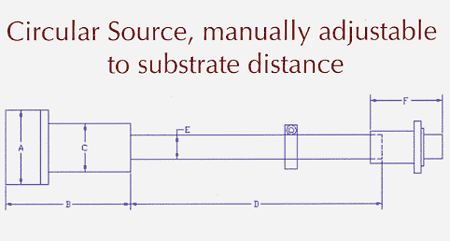
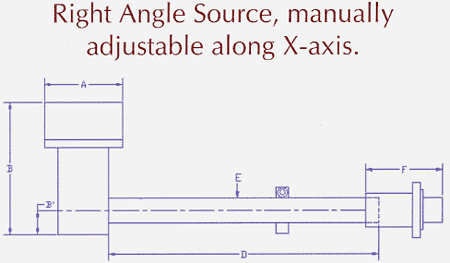


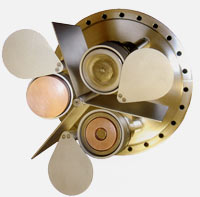
MAK Multi-source
Project/Process specific Custom packages including:
- Standard with linear adjustment
- Flexmount internally adjustable angular
- Insitu externally adjustable linear
- Insitu externally adjustable angular
RF Power Supplies, Matching Networks
DC Power Supplies
